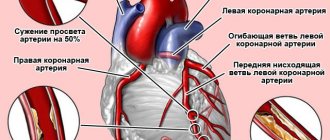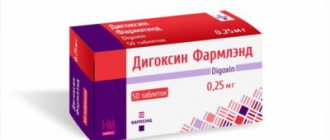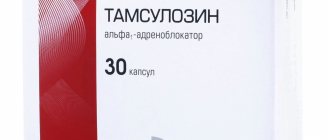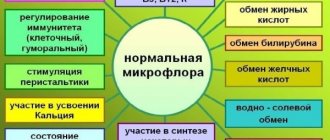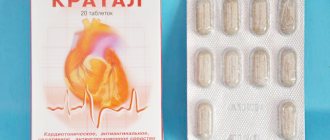Write a review
Reviews: 0
Manufacturers: Gedeon Richter-RUS
Active ingredients
- Trimetazidine
Disease class
- Not indicated. See instructions
Clinical and pharmacological group
- Not indicated. See instructions
Pharmacological action
- Antihypoxic
Pharmacological group
- Antihypoxants and antioxidants
Pharmacodynamics and pharmacokinetics
Pharmacodynamics
The drug, due to its antihypoxic effect, optimizes the functions of myocardial cells and brain neurons, improving their metabolism. The cytoprotective effect is based on enhancing energy potential and rationalizing oxygen consumption, as a result of activation of oxidative processes. Improves myocardial contractility, slows down the process of intracellular depletion of phosphocreatinine and adenosine triphosphoric acid.
In case of acidosis, it normalizes the function of ion channel membranes, the concentration of potassium ions inside cells, and prevents the accumulation of sodium and calcium in cardiomyocytes. Reduces phosphate content and intracellular acidosis.
Prevents the negative effects of free radicals, increases electrical potential, maintains the integrity of cell membranes and deactivates neutrophils in the ischemic zone. As a result, the severity of myocardial damage during ischemia is significantly reduced. The drug reduces the frequency of angina attacks. Resistance to physical activity increases, changes in blood pressure are stopped.
Pharmacokinetics
Trimetazidine after oral administration is quickly and completely absorbed from the gastrointestinal tract. The maximum concentration in the blood is reached after five hours. Bioavailability of the drug is 90%. Weakly binds to blood proteins (16%). Penetrates histohematic barriers. It is excreted unchanged mainly by the kidneys, the elimination period is about six hours.
Angiosil retard tab. By. 35 mg. No. 60 61849
Description
Angiosil® retard Sotex PharmFirma (Russia) extended-release, film-coated tablets 35 mg; contour packaging 10, cardboard pack 6; EAN code: 4605964002808; No. LS-002629, 2011-11-20 from Sotex PharmFirm (Russia); manufacturer: Replekpharm AD (Republic of Macedonia) Latin name Angiozil retard Active ingredient Trimetazidine * (Trimethazidinum) ATC: C01EB15 Trimetazidine Pharmacological group Antihypoxant agent [Antihypoxants and antioxidants] Nosological classification (ICD-10) H32 Chorioretinal disorders in diseases classified in other headingsH8 1. 9 Vestibular function disorder, unspecifiedH83.3 Noise effects of the inner earH91.9 Hearing loss, unspecifiedH93.1 Tinnitus (subjective)I20 Angina pectoris [angina pectoris]I25.9 Chronic ischemic heart disease, unspecifiedR42 Dizziness and instability Description of dosage form Tablets: round, biconvex , covered with a pink shell. Pharmacological action Pharmacological action - antihypoxic. Pharmacodynamics Trimetazidine has an antihypoxic effect. Directly affecting cardiomyocytes and neurons of the brain, it optimizes their metabolism and function. The cytoprotective effect is due to an increase in energy potential, activation of oxidative decarboxylation and rationalization of oxygen consumption (increased aerobic glycolysis and blockade of fatty acid oxidation). Supports myocardial contractility, prevents intracellular depletion of ATP and phosphocreatinine. In conditions of acidosis, it normalizes the functioning of membrane ion channels, prevents the accumulation of calcium and sodium in cardiomyocytes, and normalizes the intracellular concentration of potassium ions. Reduces intracellular acidosis and phosphate content caused by myocardial ischemia and reperfusion. Prevents the damaging effects of free radicals, preserves the integrity of cell membranes, prevents activation of neutrophils in the ischemic zone, increases the duration of the electrical potential, reduces the release of CK from cells and the severity of ischemic damage to the myocardium. In case of angina pectoris, it reduces the frequency of attacks (nitrate consumption decreases), after 2 weeks of treatment, exercise tolerance increases, and blood pressure changes decrease. Improves hearing and the results of vestibular tests in patients with pathologies of the ENT organs, reduces dizziness and tinnitus. In case of vascular pathology of the eye, it restores the functional activity of the retina. Pharmacokinetics After taking the drug orally, trimetazidine is quickly and almost completely absorbed from the gastrointestinal tract. Bioavailability - 90%. Tmax in blood plasma - 5 hours. Cmax after a single dose of 35 mg of trimetazidine - about 115 ng/ml. Easily penetrates histohematic barriers. T1/2 is about 6.5 hours. Communication with blood plasma proteins is 16%. It is excreted by the kidneys (about 60% unchanged). Indications for the drug Angiosil® retard: coronary heart disease: prevention of angina attacks (in complex therapy); chorioretinal vascular disorders; cochleovestibular disorders of ischemic nature (dizziness, tinnitus, hearing impairment). Contraindications: hypersensitivity to any component of the drug; lactase deficiency, lactose intolerance, glucose-galactose malabsorption syndrome; renal failure (creatinine Cl below 15 ml/min); severe liver dysfunction; pregnancy; breastfeeding period; age under 18 years (efficacy and safety have not been established). Use during pregnancy and lactation The drug is contraindicated during pregnancy and lactation. Side effects The frequency of side effects noted when taking trimetazidine is given in the following gradation: very often - ≥1/10; often - ≥1/100, <1/10; uncommon - ≥1/1000, <1/100; rarely - ≥1/10000, <1/1000; very rarely - <1/10000, incl. separate messages. From the digestive system: often - abdominal pain, diarrhea, dyspepsia, nausea, vomiting. From the side of the central nervous system: often - dizziness, headache, asthenia; very rarely - extrapyramidal disorders (tremor, rigidity, akinesia), reversible after discontinuation of the drug. From the skin: often - skin rash, itching, urticaria. From the cardiovascular system: rarely - orthostatic hypotension, flushing of the facial skin. Interaction Interaction with other drugs has not been described. Overdose Currently, no cases of drug overdose have been reported. Special instructions The drug is not intended for the relief of angina attacks. If an attack of angina occurs, treatment should be reviewed and adapted. The drug is not indicated for the initial course of treatment of unstable angina or myocardial infarction. Due to the lack of relevant clinical data, the drug is not recommended for patients with severe liver dysfunction. Impact on the ability to drive vehicles and operate machinery. Angiosil® retard has a slight effect on the ability to drive vehicles and perform work that requires an increased speed of psychomotor reactions. Release form: Long-acting, film-coated tablets, 35 mg. In blister packs 10 or 14 pcs. 3 or 6 contour blister packs of 10 pcs. or 2 or 4 blister packs of 14 pcs. in a cardboard pack. — CJSC “Farm. 140342, Russia, Moscow region, Egoryevsky district, pos. Shuvoe, st. Lesnaya, 40. 141345, Russia, Moscow region, Sergiev Posad municipal district, rural settlement Bereznyakovskoye, pos. Belikovo, 11. Tel./fax. or REPLEC PHARM LLC - CJSC “Farm. Skopje, Republic of Macedonia, st. Kozle, No. 188, 1000. 141345, Russia, Moscow region, Sergiev Posad municipal district, rural settlement Bereznyakovskoye, pos. Belikovo, 11. Tel./fax. Owner of the registration certificate: CJSC Pharm. Consumer complaints should be sent to the address of JSC “Pharm. Conditions for dispensing from pharmacies By prescription. Storage conditions for Angiosil® retard: In a dry place, protected from light, at a temperature not exceeding 25 °C. Keep out of the reach of children. The shelf life of the drug Angiosil® retard is 4 years. Do not use after the expiration date stated on the package. 2000-2015. Register of Medicines of Russia The database is intended for healthcare professionals. Commercial use of materials is not permitted.
Possible product names
- Angiosil retard tab. By. 35 mg. No. 60
- ANGIOSIL RETARD 35 MG TAB. No. 60
- ANGIOSIL RETARD 0.035 N60 TABLE WITH MODIF RELEASE P/O
- ANGIOSIL RETARD TABLE. PROLONG. P/O 35 MG X60
- ANGIOSIL RETARD TAB. PROLONG. ACTION P/O 35 MG No. 60
- ANGIOSIL RETARD 35MG TAB. PROLONG. ACTION P/O X60
- (Angiozil retard) Angiozil retard tab. By. 35 mg. No. 60
Reviews of Angiozile Retard
Reviews about the drug vary significantly, for example:
- “... I suffer from coronary artery disease and have been prescribed many medications. Angiosil Retard turned out to be one of the most effective. The number of attacks has decreased. I feel better.”;
- “... I have been suffering from ischemia for a long time, I took various drugs, I also tried Angiosil Retard - although the drug has a positive effect, it is significantly inferior to Preductal, Trimectal and Prekard.”
According to doctors, as a result of taking Angiosil Retard by patients with coronary artery disease with cardiac arrhythmias twice a day at a dose of 35 mg in combination with antianginal therapy for one month, the number of ventricular extrasystoles and episodes of supraventricular paroxysmal tachycardia significantly decreased.
Release form and composition
The dosage form of Angiosil retard is long-acting, film-coated tablets: biconvex, round, pink shell (10 or 14 pcs. in a blister pack, in a cardboard box 3 or 6 packs of 10 pcs. or 2 or 4 packs of 14 pcs. .).
1 film-coated tablet contains:
- active ingredient: trimetazidine dihydrochloride – 35 mg;
- auxiliary components: hypromellose, magnesium stearate, colloidal silicon dioxide, microcrystalline cellulose, opadry II (lactose monohydrate, hypromellose, triacetin, titanium dioxide, macrogol, iron oxide yellow and red).
Treatment and prevention of angina pectoris
You can often hear that angina pectoris is called “angina pectoris”; it immediately becomes clear that the main problem is heaviness in the chest area.
Seizures occur due to impaired blood supply to the myocardium. Patients often suffer from angina pectoris whose diagnosis sounds like vascular atherosclerosis.
An attack can strike at the most inopportune moment:
- During times of emotional stress
- During physical activity
- Overeating or drinking alcohol
As soon as the attack begins, you must immediately stop any loads and movements, sit down or lie down.
You should always have with you a nitroglycerin tablet or a spray containing it, which is applied sublingually, that is, under the tongue.
If the effect is not achieved, then after a few minutes you need to repeat taking the medicine, but do this no more than 3 times. If your blood pressure has increased at the same time, then a pill that lowers it will be unnecessary, since the condition will normalize after the attack has stopped.
Similar drugs:
- Neurotropin (neurotrophin) Solution for injection
- Thiotriazoline Solution for intravenous and intramuscular administration
- Deprenorm MV Oral tablets
- Sodium fumarate compound Solution for infusion
- Thiotriazoline Oral tablets
** The Drug Directory is intended for informational purposes only. For more complete information, please refer to the manufacturer's instructions. Do not self-medicate; Before starting to use the drug Angiosil retard, you should consult a doctor. EUROLAB is not responsible for the consequences caused by the use of information posted on the portal. Any information on the site does not replace medical advice and cannot serve as a guarantee of the positive effect of the drug.
Are you interested in the drug Angiosil retard? Do you want to know more detailed information or do you need a doctor's examination? Or do you need an inspection? You can make an appointment with a doctor - the Euro lab is always at your service! The best doctors will examine you, advise you, provide the necessary assistance and make a diagnosis. You can also call a doctor at home . Euro lab clinic is open for you around the clock.
** Attention! The information presented in this medication guide is intended for medical professionals and should not be used as a basis for self-medication. The description of the drug Angiosil retard is provided for informational purposes and is not intended for prescribing treatment without the participation of a doctor. Patients need to consult a specialist!
If you are interested in any other drugs and medications, their descriptions and instructions for use, information about the composition and form of release, indications for use and side effects, methods of use, prices and reviews of drugs, or you have any other questions and suggestions - write to us, we will definitely try to help you.
Contraindications
- age under 18 years (the safety profile of trimetazidinau in children and adolescents has not been studied);
- During pregnancy and breastfeeding;
- tremor, symptoms of parkinsonism, Parkinson's disease, restless leg syndrome, and other similar movement disorders;
- glucose-galactose malabsorption syndrome, lactose intolerance, lactase deficiency;
- severe functional disorders of the liver (due to the lack of clinical trial data);
- renal failure (creatinine clearance less than 15 ml/min);
- hypersensitivity to the components of the drug.
It is recommended to use the drug with caution in patients with moderate renal failure, as well as in elderly patients (over 75 years of age).
Side effects
The frequency of side effects observed when taking trimetazidine from organs and systems (according to gradation: very often - >1/10; often - >1/100-<1/10; infrequently - >1/1000-<1/ 100); rarely – >1/10,000-<1/1000); very rare - <1/10,000 (including isolated reports)):
- digestive system: often – diarrhea, dyspepsia, abdominal pain, nausea, vomiting;
- central nervous system: often – headache, dizziness, asthenia; very rarely - extrapyramidal disorders (rigidity, tremor, akinesia) (these reactions are reversible and disappear after discontinuation of the drug);
- skin: often – urticaria, itching, skin rash;
- cardiovascular system: rarely - orthostatic hypotension, flushing of the face.
special instructions
Trimetazidine is not used to relieve angina attacks; if a heart attack develops, it is recommended to review and adapt therapy.
Do not use the drug in the initial course of treatment of myocardial infarction or unstable angina.
Due to the lack of data from clinical studies of the use of the drug in severe liver dysfunction, it is not recommended to prescribe antihypoxants to this category of patients.
Angiosyl retard has little effect on the ability to drive vehicles and perform work that requires increased concentration and speed of psychomotor reactions.
